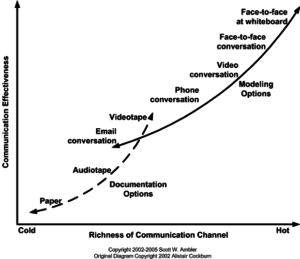“ ‘Scuse me while I kiss this guy” — Not Jimi Hendrix
The quote above is from an entertaining book by Gavin Edwards about how musical lyrics have been misinterpreted. Some might say that Jimi Hendrix’s actual lyrics from “Purple Haze”, “Excuse me while I kiss the sky,” might be about reaching for your own dreams (or maybe just about a hallucinogenic acid trip). But one thing is for sure — Mr. Hendrix did not intend the line to be interpreted as taking a time-out to kiss a random dude.
It’s natural to assume the message we intend is the one people receive. In reality, we can say the same thing over and over again and its meaning can still be missed. Communication is your primary tool for managing up, down, and across an organization. Our every move is interpreted and analyzed — and as we saw above, it’s really easy to misunderstand what someone is trying to say. Luckily, Hendrix didn’t have to worry about what someone thought he said — he had a catchy tune which could still keep fans interested. As managers and leaders, our job is to not just come up with the best answers to problems we face, but to communicate in a way that others will understand. We must be students of communication and constantly aware of how we can deliver a message in the best way possible.
Today, we have many different communication options at our disposal. These options range from texts to conference calls to in-person meetings. Not to mention emails that continue to fill our inboxes. Every form of communication has its assets and liabilities and all of them have the opportunity for misinterpretation. The perspective of the person who you are communicating with and your goal should determine what medium to use. By extension, we must create an environment where people in the organization can effectively communicate with one another.
The value of each form of communication is directly proportional to how the receiver can interpret and respond. If information is brief and simple, a text might be the best route (thankfully emoji can help us speak for our emotion and tone). If the stakes are high and dense communication is necessary, a live meeting makes the most sense. Media Richness Theory (MRT) provides a framework to understand how different media enable understanding.

- What is the desired outcome? It is important to define the actions you want someone to take out of the communication. Knowing your objective and how the recipient can internalize that objective will point you towards the degree of interaction required. A widely available digital plan and communication repository can be a guiding light to provide context to objectives.
- How complex is the message? Complexity occurs in a variety of dimensions. To define message complexity further, consider: — How well do you know the person to whom you are delivering a message? — What level of personal experience and specialized knowledge does the person have on the topic? — How many parts of the organization (or outside the organization) does the topic impact or require effort from? — Do we actually understand what we need to do? Or does it require the effort of multiple individuals to figure that out?
- How important is the message? As I have mentioned before, time spent in an in-person meeting is the most expensive, so that should be used in a targeted and deliberate manner. Urgency and novelty can drive your medium choice. Most people receive text notifications in a relatively prominent way — an urgent, brief, and pointed message in this format is likely to be understood quickly and acted upon.
- What interaction is needed? If the interaction is minimal (or not required), an email can suffice. Don’t expect an email debate to yield a clear outcome though. For conversations that engender many questions and uncertain outcomes, text won’t suffice — a phone, video, or in-person meeting is necessary.
- How many people are involved in the communication? The more participants in the communication, the more difficult it will be to deliver a nuanced message. Concise and clear messages are always a goal.
“The single biggest problem in communication is the illusion that it has taken place.” — George Bernard Shaw (Irish Playwright)
As Mr. Shaw eloquently stated, it’s tough to say what someone took out of a communication. Always consider the recipient as well as how your message and chosen medium influences arriving at a desired outcome. Communicating effectively requires a great deal of thoughtful attention. Do it well and everything else gets easier!
By Matt Sitter
Matt is Chief Client Services Officer for CrossLead, Inc. He advises C-level and executive staffs on operations, communications, organizational development, and strategic alignment. Matt’s experience spans leadership roles across multiple functions in the healthcare industry and management consulting. His passions are to make organizations, teams, and leaders the best they can be and building a healthier world through technology.


